Effects of SOP Lagoon Additive on Gaseous Emissions from Stored Liquid Dairy Manure
Abstract
1. Introduction
2. Materials and Methods
2.1. Experimental Design
2.2. Manure Collection and Experimental Setup
2.3. Air Sampling Using Emission Flux Chambers
2.4. Environmental Measures
2.5. Emission Calculation
2.6. Odor Intensity Calculation
2.7. Statistical Analysis
3. Results and Discussion
3.1. Effect of SOP on GHG Emissions
3.2. Effect of SOP on NH3 Emissions
3.3. Effect of SOP on Odor
4. Discussion
5. Conclusions
Author Contributions
Acknowledgments
Conflicts of Interest
References
- IPCC. Climate Change 2014: Synthesis Report. Contribution of Working Groups I, II and III to the Fifth Assessment Report of the Intergovernmental Panel on Climate Change; IPCC: Geneva, Switzerland, 2014; p. 151. [Google Scholar]
- U.S. EPA. Inventory of US Greenhouse Gas Emissions and Sinks: 1990–2017; U.S. EPA: Washington, DC, USA, 2019.
- Forster, P.; Ramaswamy, V.; Artaxo, P.; Berntsen, T.; Betts, R.; Fahey, D.W.; Haywood, J.; Lean, J.; Lowe, D.C.; Myhre, G. Changes in atmospheric constituents and in radiative forcing. In Climate Change 2007: The Physical Science Basis; Chapter 2; Intergovernmental Panel on Climate Change: Geneva, Switzerland, 2007. [Google Scholar]
- Allen, M.R.; Shine, K.P.; Fuglestvedt, J.S.; Millar, R.J.; Cain, M.; Frame, D.J.; Macey, A.H. A solution to the misrepresentations of CO2-equivalent emissions of short-lived climate pollutants under ambitious mitigation. Clim. Atmos. Sci. 2018, 1, 16. [Google Scholar] [CrossRef]
- IPCC. Emissions from livestock and manure management. In Guidelines for National Greenhouse Gas Inventories; Agriculture, Forestry and Other Land Use; Dong, H., Mangino, J., McAllister, T.A., Hatfield, J.L., Johnson, D.E., Lassey, K.R., Romanovskaya, A., Eds.; IPCC: Geneva, Switzerland, 2006; Volume 4. [Google Scholar]
- Phillips, V.; Scholtens, R.; Lee, D.; Garland, J.; Sneath, R. A review of methods for measuring emission rates of ammonia from livestock buildings and slurry or manure stores, part 1: Assessment of basic approaches. J. Eng. Res. 2000, 77, 355–364. [Google Scholar]
- Wu, Y.; Gu, B.; Erisman, J.W.; Reis, S.; Fang, Y.; Lu, X.; Zhang, X. PM2.5 pollution is substantially affected by ammonia emissions in China. Environ. Pollut. 2016, 218, 86–94. [Google Scholar] [CrossRef] [PubMed]
- American Lung Association. State of the Air. 2018. Available online: https://www.lung.org/assets/documents/healthy-air/state-of-the-air/sota-2018-full.pdf (accessed on 27 June 2018).
- Owen, J.J.; Silver, W.L. Greenhouse gas emissions from dairy manure management: A review of field-based studies. Glob. Chang. Biol. 2015, 21, 550–565. [Google Scholar] [CrossRef]
- Short-lived climate pollutants: Methane emissions: Dairy and livestock: Organic waste: Landfills. In Statutes of 2016; Chapter 395; California State Legislature: Sacramento, CA, USA, 2016.
- Leytem, A.B.; Dungan, R.S.; Bjorneberg, D.L.; Koehn, A.C. Greenhouse gas and ammonia emissions from an open-freestall dairy in southern Idaho. J. Environ. Qual. 2013, 42, 10–20. [Google Scholar] [CrossRef]
- Wheeler, E.F.; Adviento-Borbe, M.A.A.; Brandt, R.C.; Topper, P.A.; Topper, D.A.; Elliott, H.A.; Graves, R.E.; Hristov, A.N.; Ishler, V.A.; Bruns, M.A.V. Manure amendments for mitigation of dairy ammonia and greenhouse gas emissions: Preliminary screening. Agric. Eng. Int. CIGR J. 2011, 13, 1–15. [Google Scholar]
- McCrory, D.; Hobbs, P. Additives to reduce ammonia and odor emissions from livestock wastes. J. Environ. Qual. 2001, 30, 345–355. [Google Scholar] [CrossRef]
- Martinez, J.; Guiziou, F.; Peu, P.; Gueutier, V. Influence of treatment techniques for pig slurry on methane emissions during subsequent storage. Biosyst. Eng. 2003, 85, 347–354. [Google Scholar] [CrossRef]
- Shah, S.B.; Kolar, P. Evaluation of additive for reducing gaseous emissions from swine waste. Agric. Eng. Int. CIGR J. 2012, 14, 10–20. [Google Scholar]
- Holly, M.A.; Larson, R.A. Effects of manure storage additives on manure composition and greenhouse gas and ammonia emissions. Trans. ASABE 2017, 60, 449–456. [Google Scholar]
- Xue, S.; Chen, S. Surface oxidation for reducing ammonia and hydrogen sulfide emissions from dairy manure storage. Trans. ASAE 1999, 42, 1404. [Google Scholar]
- Petersen, S.O.; Andersen, A.J.; Eriksen, J. Effects of cattle slurry acidification on ammonia and methane evolution during storage. J. Environ. Qual. 2012, 41, 88–94. [Google Scholar] [CrossRef] [PubMed]
- Febrisiantosa, A.; Ravindran, B.; Choi, H. The effect of co-additives (Biochar and FGD Gypsum) on ammonia volatilization during the composting of livestock waste. Sustainability 2018, 10, 795. [Google Scholar] [CrossRef]
- Li, Y.; Luo, W.; Li, G.; Wang, K.; Gong, X. Performance of phosphogypsum and calcium magnesium phosphate fertilizer for nitrogen conservation in pig manure composting. Bioresour. Technol. 2018, 250, 53–59. [Google Scholar] [CrossRef]
- Yang, F.; Li, G.; Shi, H.; Wang, Y. Effects of phosphogypsum and superphosphate on compost maturity and gaseous emissions during kitchen waste composting. Waste Manag. 2015, 36, 70–76. [Google Scholar] [CrossRef]
- Tubail, K.; Chen, L.; Michel, F.C., Jr.; Keener, H.M.; Rigot, J.F.; Klingman, M.; Kost, D.; Dick, W.A. Gypsum additions reduce ammonia nitrogen losses during composting of dairy manure and biosolids. Compost. Sci. Util. 2008, 16, 285–293. [Google Scholar] [CrossRef]
- Hao, X.; Larney, F.J.; Chang, C.; Travis, G.R.; Nichol, C.K.; Bremer, E. The effect of phosphogypsum on greenhouse gas emissions during cattle manure composting. J. Environ. Qual. 2005, 34, 774–781. [Google Scholar] [CrossRef]
- Borgonovo, F.; Conti, C.; Lovarelli, D.; Ferrante, V.; Guarino, M. Improving the sustainability of dairy slurry by a commercial additive treatment. Sustainability 2019, 11, 4998. [Google Scholar] [CrossRef]
- Casey, K.D.; Bicudo, J.R.; Schmidt, D.R.; Singh, A.; Gay, S.W.; Gates, R.S.; Jacobson, L.D.; Hoff, S.J. Air quality and emissions from livestock and poultry production/waste management systems. In Animal Agriculture and the Environment: National Center for Manure and Animal Waste Management White Papers; ASABE: St. Joseph, MI, USA, 2006; pp. 1–40. [Google Scholar]
- Sheffield, R.; Thompson, M.; Dye, B.; Parker, D. Evaluation of field-based odor assessment methods. Proc. Water Environ. Fed. 2004, 2004, 870–879. [Google Scholar] [CrossRef][Green Version]
- Lenth, R.V. Least-squares means: The R package lsmeans. J. Stat. Softw. 2016, 69, 33. [Google Scholar] [CrossRef]
- Piepho, H.-P. An algorithm for a letter-based representation of all-pairwise comparisons. J. Comput. Graph. Stat. 2004, 13, 456–466. [Google Scholar] [CrossRef]
- Møller, H.B.; Sommer, S.G.; Ahring, B.K. Biological degradation and greenhouse gas emissions during pre-storage of liquid animal manure. J. Environ. Qual. 2004, 33, 27–36. [Google Scholar] [CrossRef]
- Maeda, K.; Toyoda, S.; Shimojima, R.; Osada, T.; Hanajima, D.; Morioka, R.; Yoshida, N. Source of nitrous oxide emissions during the cow manure composting process as revealed by isotopomer analysis of and amoA abundance in betaproteobacterial ammonia-oxidizing bacteria. Appl. Environ. Microbiol. 2010, 76, 1555–1562. [Google Scholar] [CrossRef] [PubMed]
- Bastami, M.S. Mitigating Greenhouse Gases Emission from Cattle Slurry: An Approach for Small-Medium Scale Farms; Prifysgol Bangor University: Wales, UK, 2016. [Google Scholar]
- Sommer, S.G.; Clough, T.J.; Chadwick, D.; Petersen, S.O. Greenhouse gas emissions from animal manures and technologies for their reduction. Anim. Manure Recycl. Treat. Manag. 2013, 177–194. [Google Scholar] [CrossRef]
- Grant, R.H.; Boehm, M.T. Manure ammonia and hydrogen sulfide emissions from a western dairy storage basin. J. Environ. Qual. 2015, 44, 127–136. [Google Scholar] [CrossRef]
- Watts, D.B.; Dick, W.A. Sustainable uses of FGD gypsum in agricultural systems: Introduction. J. Environ. Qual. 2014, 43, 246–252. [Google Scholar] [CrossRef]
- Chang, A.; Harter, T.; Letey, J.; Meyer, D.; Meyer, R.; Mathews, M.C.; Mitloehner, F.; Pettygrove, S.; Robinson, P.; Zhang, R. Managing Dairy Manure in the Central Valley of California; University of California: Oakland, CA, USA, 2005. [Google Scholar]
- Casagrande Proietti, P.; Franceschini, R.; Pennacchi, M.; Tacconi, G. Evaluation of the efficacy of a litter additive in the control of Staphylococcus spp. and coliform levels: Preliminary results of a field trial on organic chianina beef cattle. In Proceedings of the 4th World Italian Beef Cattle Congress, Gubbio, Italy, 29 April–1 May 2005. [Google Scholar]
- Tacconi, G.; Pennacchi, M.; Boni, P.; Covarelli, A.; Zanierato, A. Efficacy of a bio-hygienization additive on microbial control in dairy cow bedding. In Proceedings of the NMC 46th Annual Meeting, San Antonio, TX, USA, 21–24 January 2007. [Google Scholar]
- Zanierato, A.; Buzzini, P. Efficacy of a Bio-hygienization Additive in controlling the yeast-like microalga Prototheca zopfii. Cattle Sect. 2008, 4, 15. [Google Scholar]
- Favretti, M.; Moroni, P.; Bronzo, V.; Cavalli, S.; Zanierato, A. Monitoring of the efficacy of a bio-hygienization treatment on the reduction of the microbial load in cubicles with mats of an Italian dairy herd. In Proceedings of the NMC 49th Annual Meeting, Albuquerque, NM, USA, 1–7 May 2010. [Google Scholar]
- Zanierato, A.; Casalone, M.; Luparia, P.; Bronzo, V.; Moroni, P. Annual monitoring of the SCC on a commercial Italian farm treated with SOP C COW. In Proceedings of the NMC 50th Annual Meeting, Arlington, VA, USA, 23–26 January 2011. [Google Scholar]
- Luparia, P.; Poggianella, M.; Bronzo, V. Investigation on a bio-hygienizing additive for oral use in dairy cows: Effect on milk somatic cell count. In Proceedings of the Joint Annual Meeting, Phoenix, AZ, USA, 15–19 July 2012. [Google Scholar]
- Luparia, P.; Rota, N.; Poggianella, M.; Bronzo, V. Preliminary results of in-field monitoring of a feed additive for rumen functionality on 7 Italian commercial dairy farms. In Proceedings of the European Society of Veterinary and Comparative Nutrition (ESVCN) Congress, Touolouse, France, 17–19 September 2015. [Google Scholar]
- Bronzo, V.; Zanierato, A.; Varano, R.; Moroni, P. Monitoring of the efficacy of a bio-hygienization treatment on the reduction of the microbial load on cubicles in an Italian dairy herd. In Proceedings of the NMC 48th Annual Meeting, Charlotte, NC, USA, 25–28 January 2009. [Google Scholar]
- Sharkey, H.L.; Zanierato, A.; Luparia, P.; Poggianella, M.; Moroni, P.; Schukken, Y. SOP treatment of separate manure solids reduced Klebsiella bacteria counts. Cattle Sect. 2011, 136, 142. [Google Scholar]
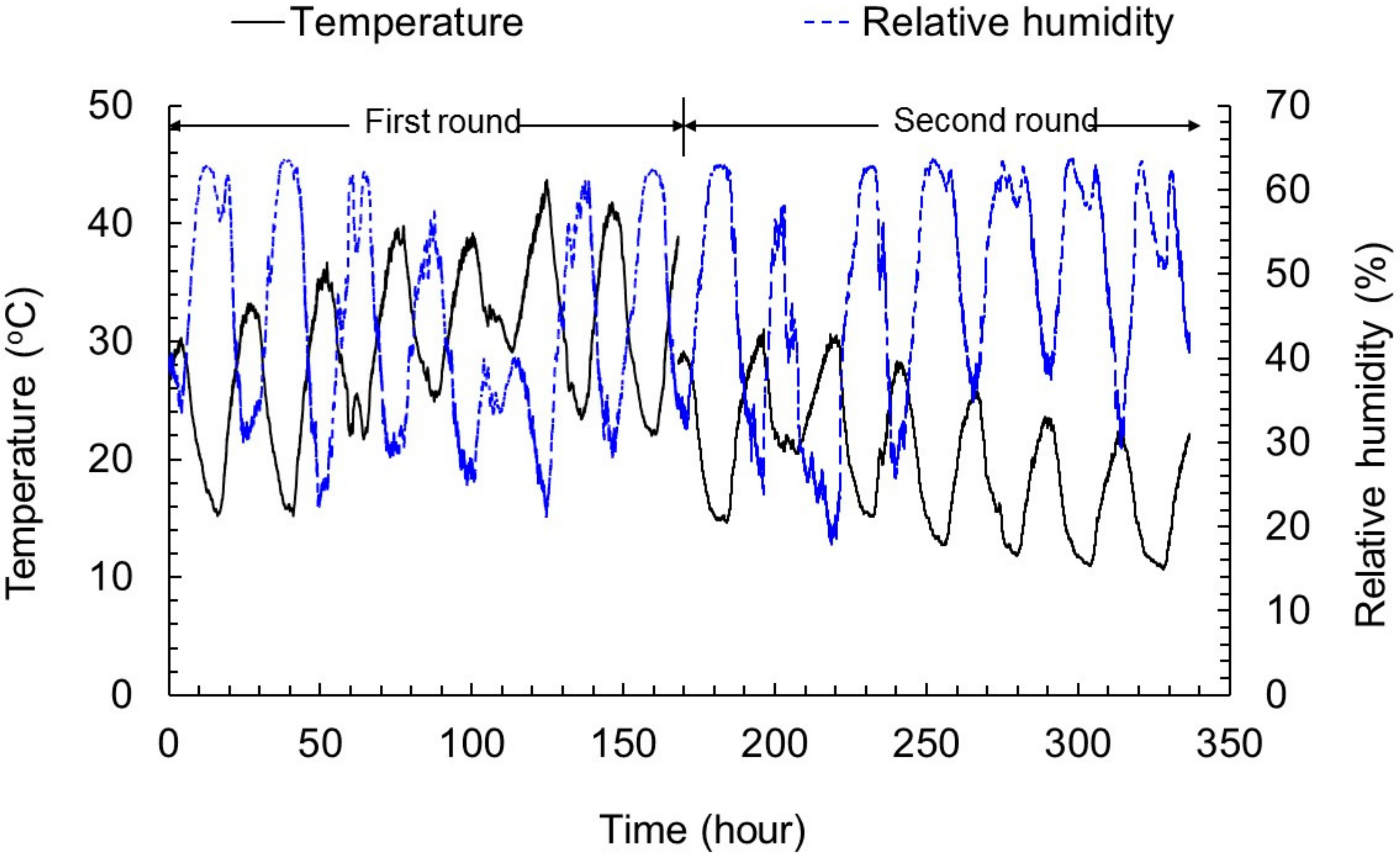
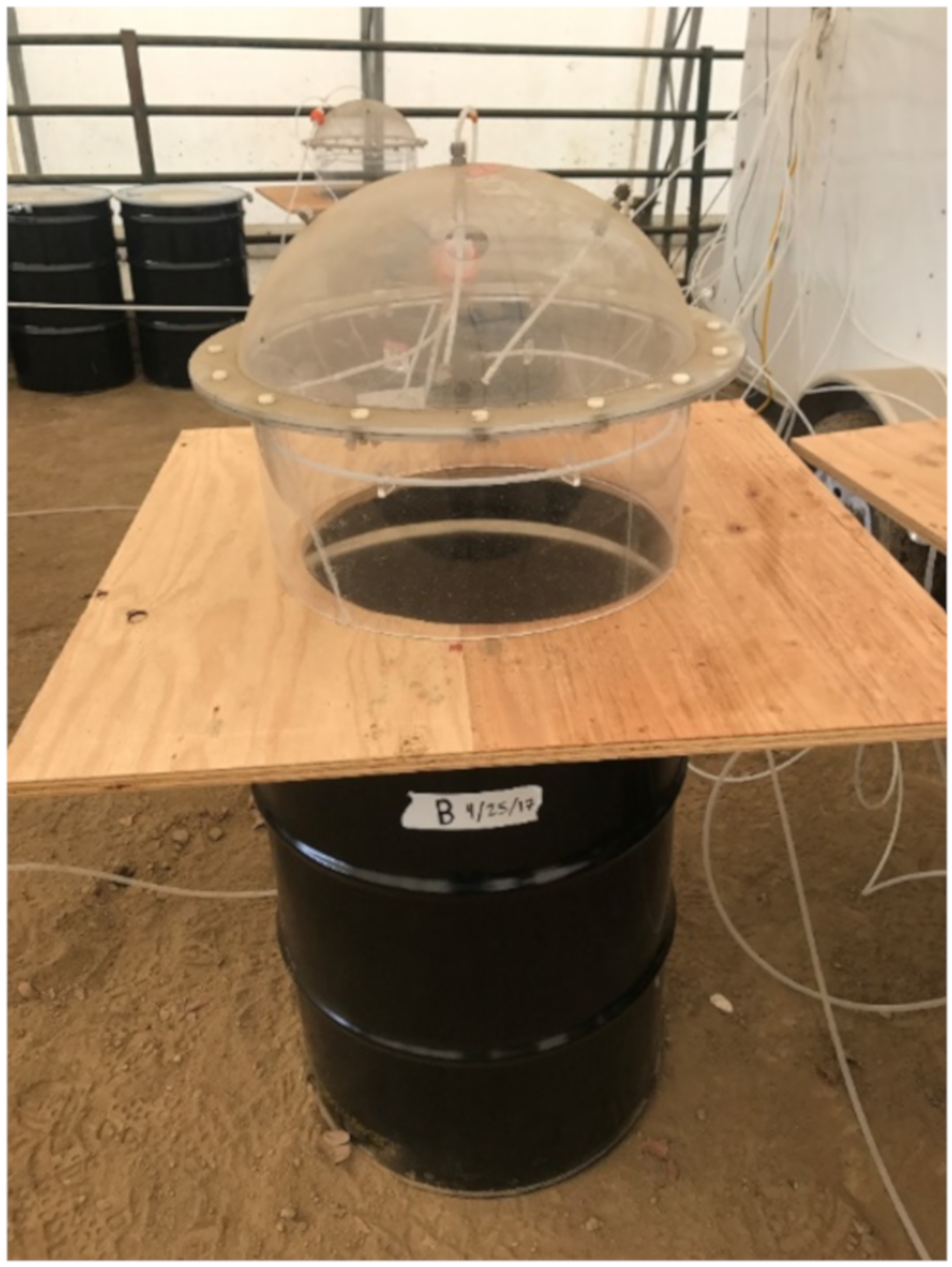
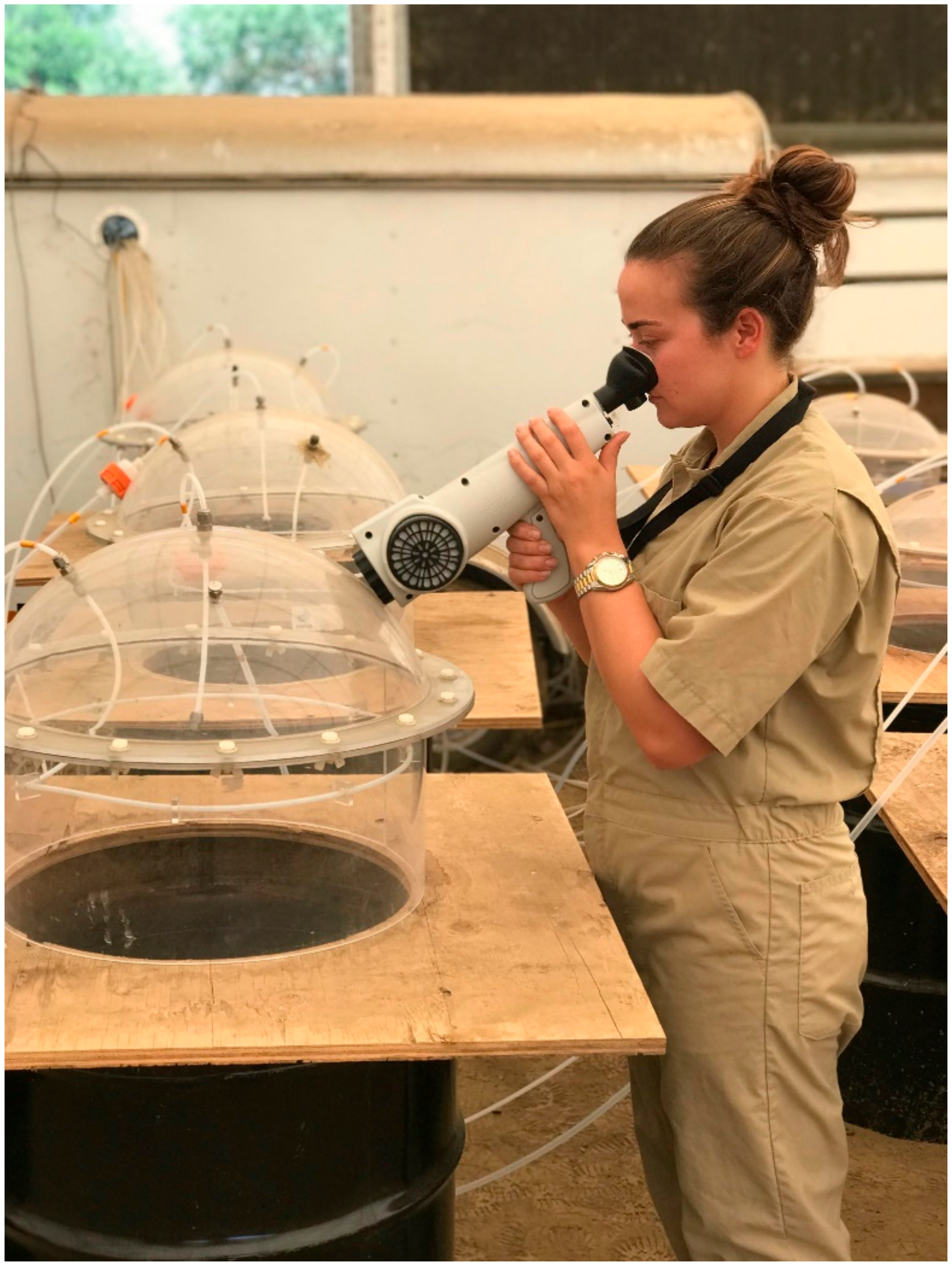
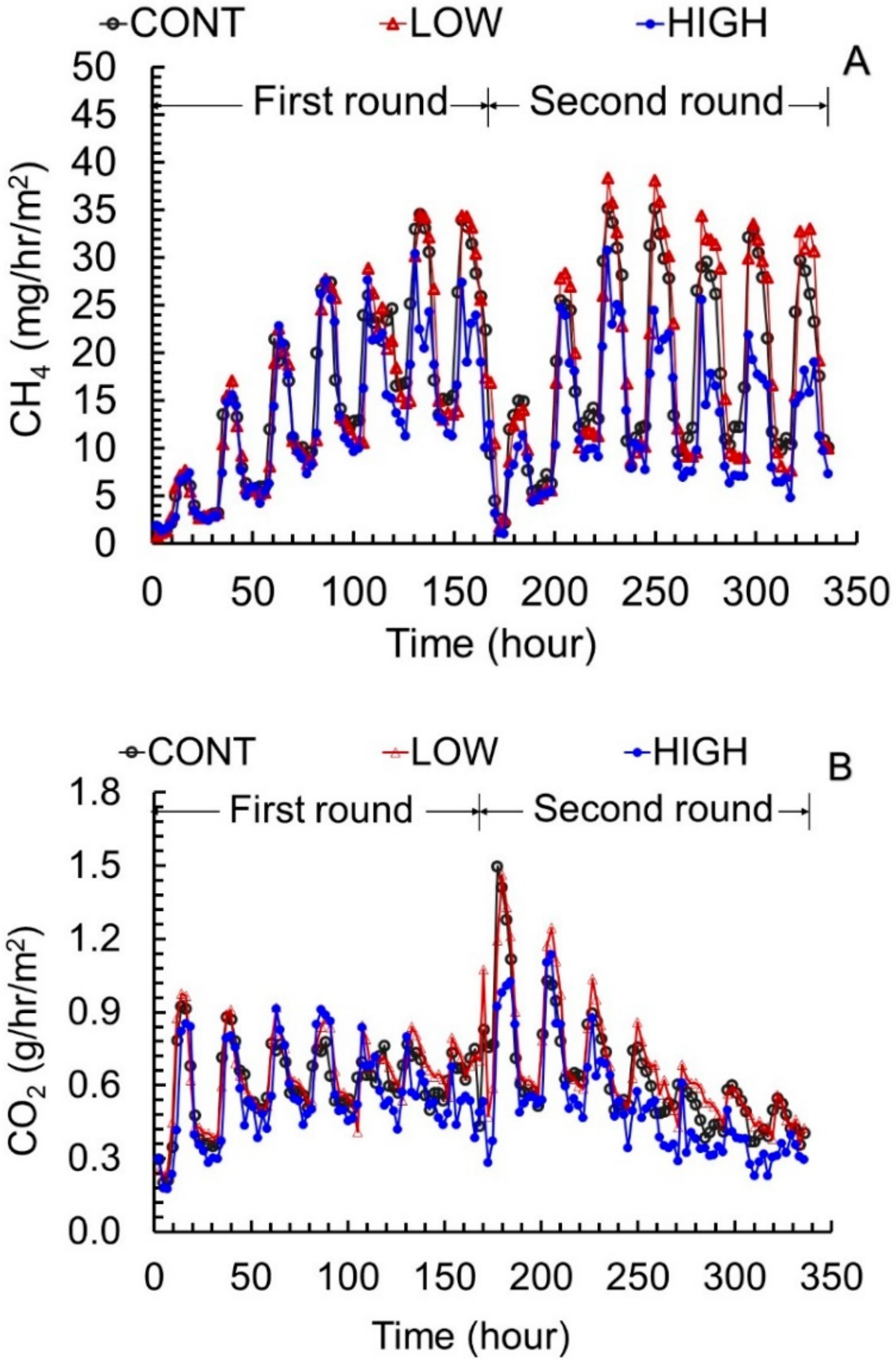
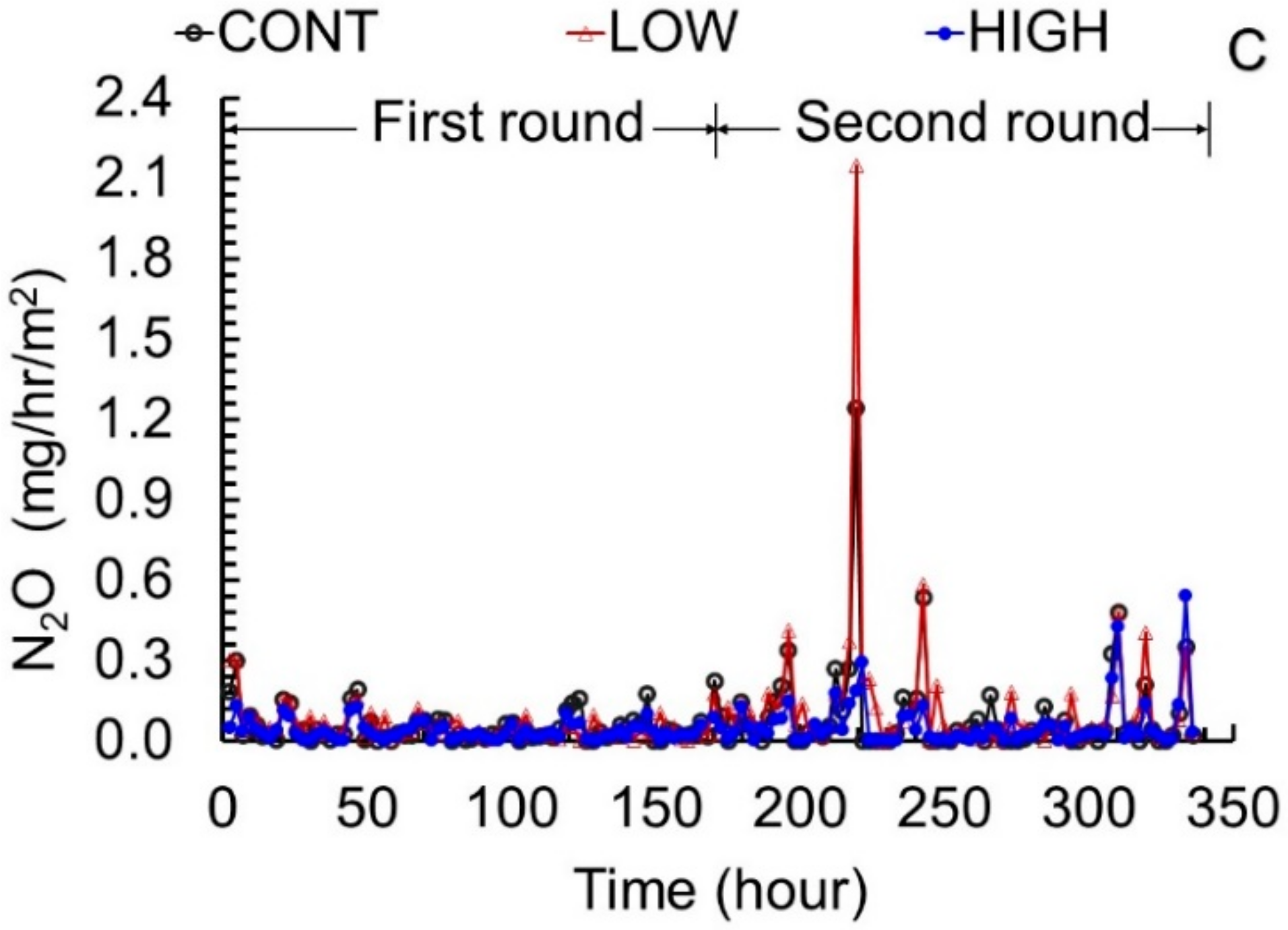
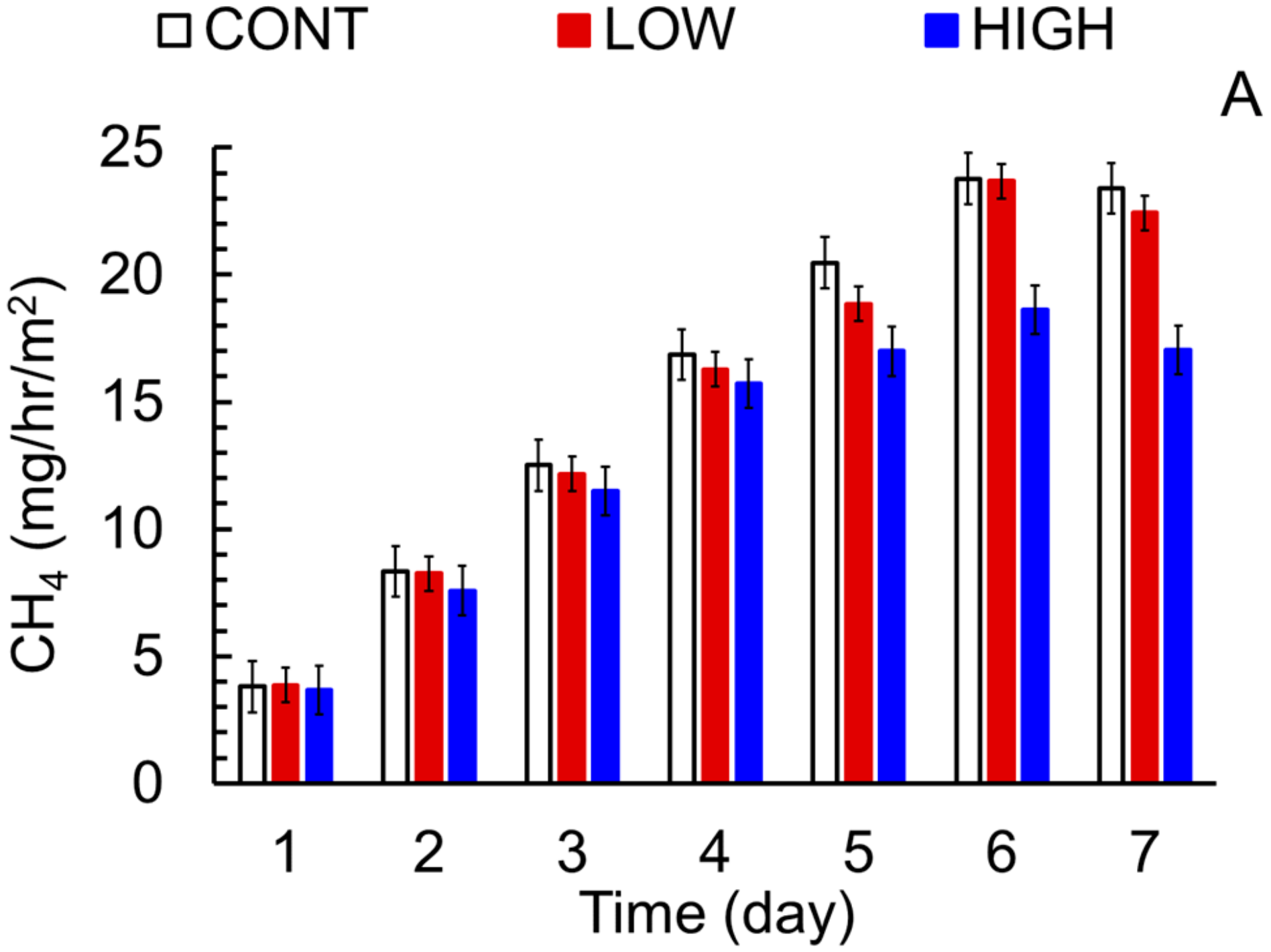

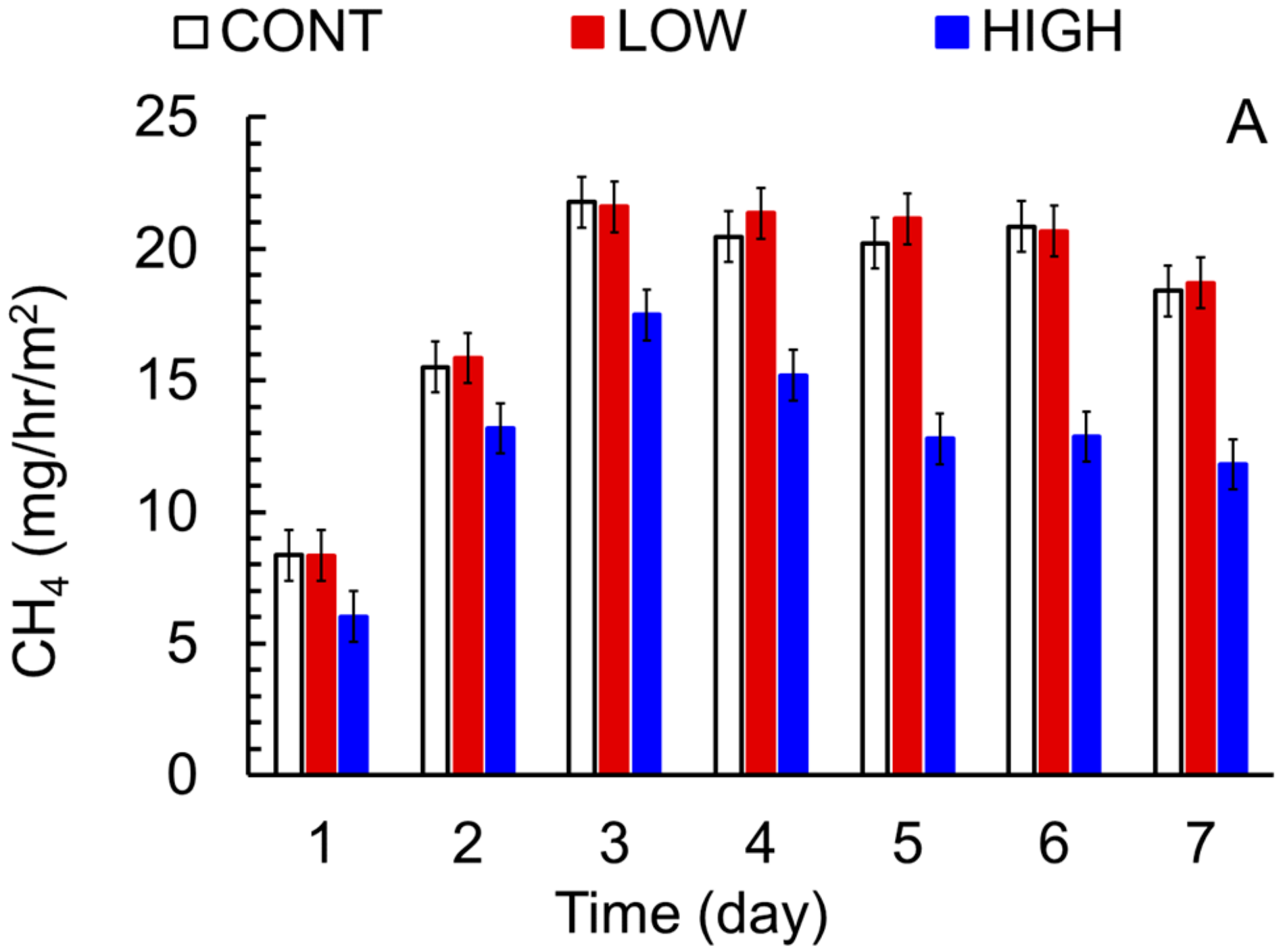
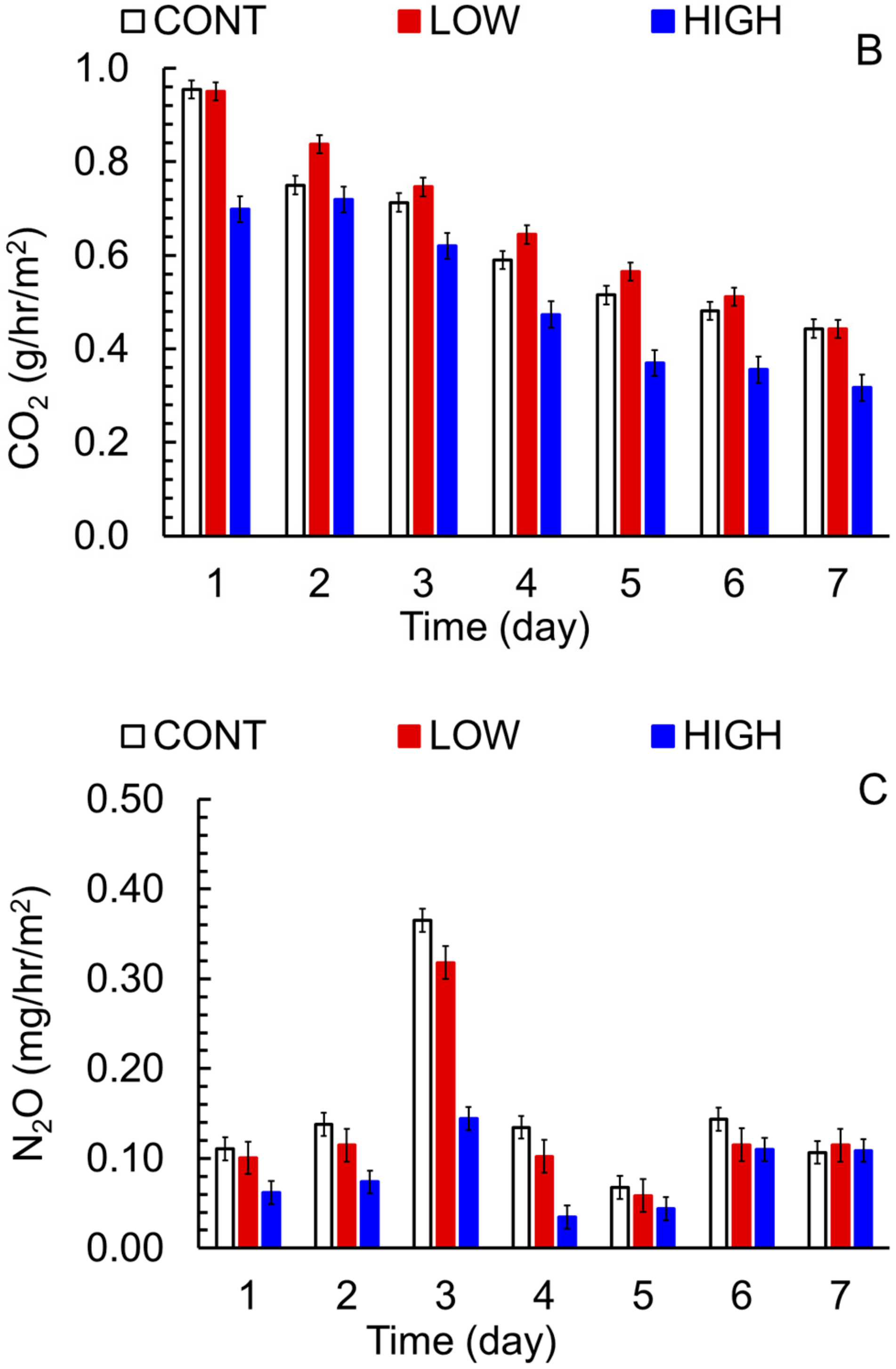
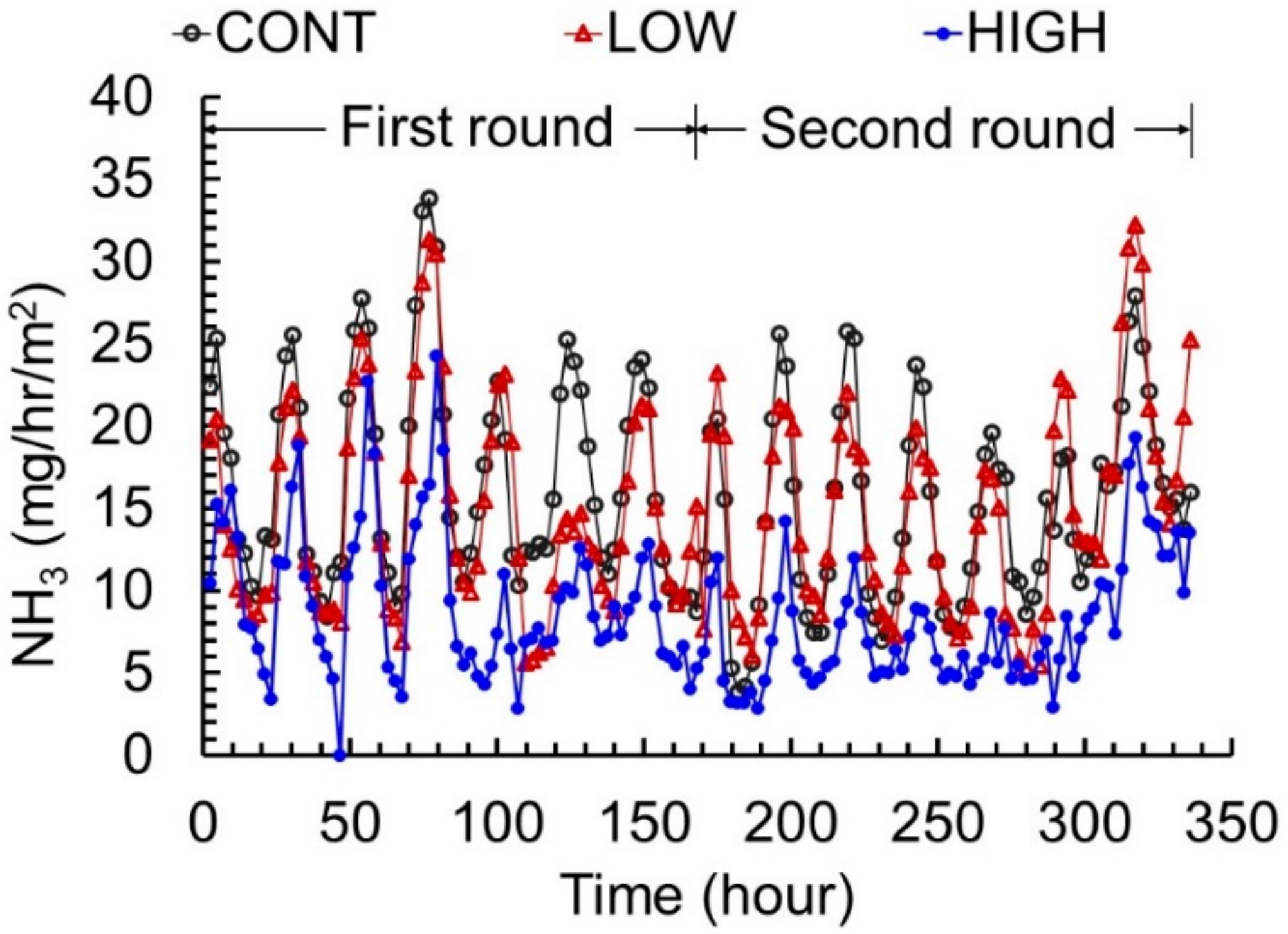
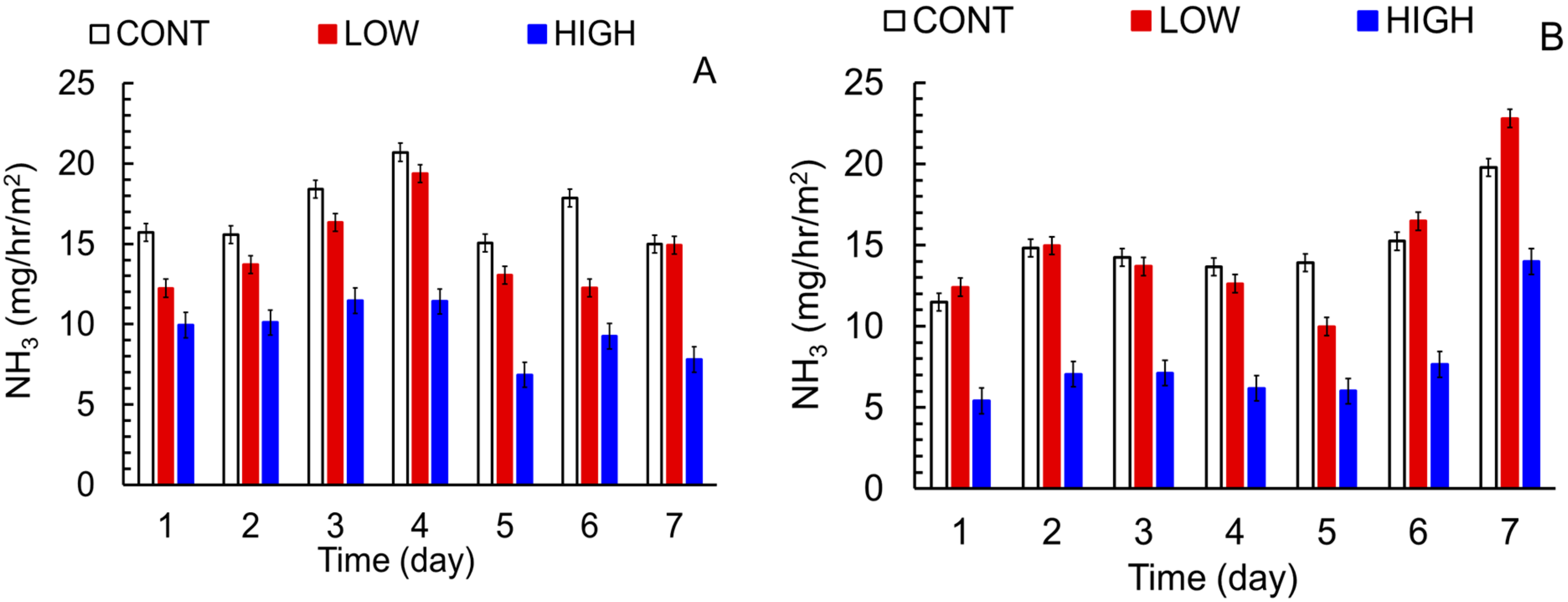

| Trait | LSM of SOP Lagoon Treatments | SEM | p-Value | ||||||||
|---|---|---|---|---|---|---|---|---|---|---|---|
| CONT | LOW | HIGH | Treatments(Trt) | Days | Rounds | Trt × Days | Trt × Rounds | Days × Rounds | Trt × Days × Rounds | ||
| CH4 (mg/h/m2) | 16.76 a,* | 16.65 a | 12.89 b | 0.68 | <0.001 | <0.001 | 0.031 | 0.90 | 0.19 | <0.001 | 1.00 |
| CO2 (g/h/m2) | 0.62 a | 0.66 a | 0.53 b | 0.02 | <0.001 | <0.001 | 0.857 | 1.00 | 0.33 | <0.001 | 1.00 |
| N2O (mg/h/m2) | 0.11 a | 0.10 a | 0.06 a | 0.01 | 0.051 | 0.006 | <0.001 | 0.97 | 0.35 | 0.002 | 0.92 |
| NH3 (mg/h/m2) | 15.82 a | 14.61 a | 8.58 b | 0.55 | <0.001 | 0.003 | 0.045 | 0.98 | 0.29 | <0.001 | 0.96 |
| Odor (D/T) | 53.17 a | 56.36 b | 48.51 c | 0.89 | <0.001 | <0.001 | <0.001 | <0.001 | 0.10 | <0.001 | 0.15 |
| Emitted Gas | SOP Lagoon Treatments | ||
|---|---|---|---|
| CONT | LOW | HIGH | |
| CH4 | 64.66 ± 10.70 | 64.24 ± 8.52 | 49.71 ± 10.05 |
| CO2 | 2399.24 ± 381.45 | 2530.96 ± 222.55 | 2044.27 ± 288.90 |
| N2O | 0.41 ± 0.23 | 0.37 ± 0.25 | 0.24 ± 0.09 |
| NH3 | 61.01 ± 10.93 | 56.36 ± 9.56 | 33.08 ± 5.05 |
© 2020 by the authors. Licensee MDPI, Basel, Switzerland. This article is an open access article distributed under the terms and conditions of the Creative Commons Attribution (CC BY) license (http://creativecommons.org/licenses/by/4.0/).
Share and Cite
Peterson, C.B.; El Mashad, H.M.; Zhao, Y.; Pan, Y.; Mitloehner, F.M. Effects of SOP Lagoon Additive on Gaseous Emissions from Stored Liquid Dairy Manure. Sustainability 2020, 12, 1393. https://doi.org/10.3390/su12041393
Peterson CB, El Mashad HM, Zhao Y, Pan Y, Mitloehner FM. Effects of SOP Lagoon Additive on Gaseous Emissions from Stored Liquid Dairy Manure. Sustainability. 2020; 12(4):1393. https://doi.org/10.3390/su12041393
Chicago/Turabian StylePeterson, Carlyn B., Hamed M. El Mashad, Yongjing Zhao, Yuee Pan, and Frank M. Mitloehner. 2020. "Effects of SOP Lagoon Additive on Gaseous Emissions from Stored Liquid Dairy Manure" Sustainability 12, no. 4: 1393. https://doi.org/10.3390/su12041393
APA StylePeterson, C. B., El Mashad, H. M., Zhao, Y., Pan, Y., & Mitloehner, F. M. (2020). Effects of SOP Lagoon Additive on Gaseous Emissions from Stored Liquid Dairy Manure. Sustainability, 12(4), 1393. https://doi.org/10.3390/su12041393





